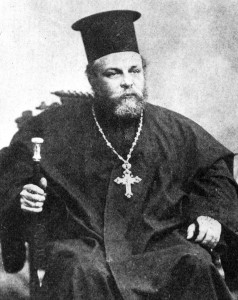Before I get started, I wanted to let you all know that I do plan to finish my series on St. Raphael and the Syrian controversies of 1905. However, I’ve got several other irons in the fire, so I’m going to take a little time off of that project to present some other research. But don’t worry; we’ll get back to it.
Anyway, recently, I took another look at the 1916 Census of Religious Bodies, conducted by the US Census Bureau. The census includes data on numerous aspects of American Orthodox church life in the mid-teens, including clergy salaries. Of the seven Orthodox groups reported in the census, six — all but the Syrians — provided data on clergy pay. Of those six bodies, three — the Albanians, Bulgarians, and Romanians — provided salary information on just two priests apiece:
- Albanian priests averaged $780/year, or $15,187 in 2009 currency.
- Bulgarian priests averaged $850/$16,549.
- Romanian priests averaged $570/$11,098.
Obviously, the sample sizes are small, but it’s clear that none of these priests were making much money. Here is the data for the larger groups:
- 93 Greek priests reported an average of $913/year, or $17,776 in 2009 currency.
- 149 Russian priests reported $762/$14,836.
- 11 Serbian priests reported $1050/$20,443.
The average salary for all American Orthodox priests in 1916 was $828, equivalent to just $16,117 in modern terms. (Inflation data courtesy of www.westegg.com/inflation.) I should emphasize that these numbers are based only on the clergy who reported their salaries to the Census Bureau; other priests did not report, including, as I said, all of the Syrian clergy.
Obviously, the 1916 salaries are startlingly low. Even the Serbs — the highest-paid group — were scraping by by modern standards. However, things were quite a bit different in 1916 than they are today. Many parishes had rectories or parsonages, so a lot of these priests didn’t have to pay for their housing. Some of our biggest expenses — health care, transportation, various forms of insurance — would have been minimal 94 years ago. And while I don’t have any hard data to support this, it’s my impression that a higher proportion of clergy were unmarried in 1916 than in 2010.
In addition to all those facts, there is a high probability that the reported salaries don’t include honoraria for weddings, baptisms, funerals, house blessings, and the like. In other words, simply taking the 1916 base salaries, plugging them into a calculator, and figuring out their modern equivalent, is not really an accurate way to determine how well American Orthodox clergy were actually compensated in 1916.
Beyond the seemingly low numbers overall, I was struck by the fact that the Russian clergy reported significantly lower salaries than their Greek and Serbian counterparts. The Russian Church in America was substantially subsidized by the Russian government in 1916, whereas the Greek and Serbian parishes primarily relied on local funding. Nevertheless, the Russian clergy were among the lowest-paid in America.
[This article was written by Matthew Namee.]

Both my grandfathers were Russian Orthodox priests (Metropolia) beginning in the 1930s, serving parishes in PA, West Virginia, Ohio, New Jersey, Connecticut. Their rural parishioners often “paid” them from their farms with vegetables, eggs, milk, chickens, etc. A Gypsy family even gave my one grandfather gold coins for funerals and other services. They often depended heavily on “trebi” or honoria, especially during the blessing of homes season. This custom, tho, was used to keep their salaries low because the mentality (which continues in some places today) was that the priest had another stream of income in addition to his fixed salary.